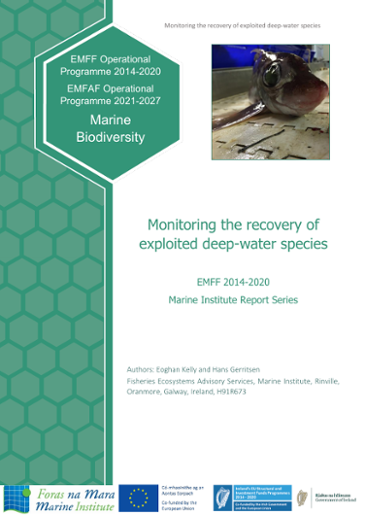Several deep-water species have suffered stock collapse as a result of commercial exploitation. ICES has advised a zero catch for orange roughy since 2004 and for Portuguese dogfish and leafscale gulper shark since 2005. These species began to be exploited in the early 1990s, and by the end of the decade they had already declined strongly in abundance. Some of these deep-sea fisheries continue, and these species continue to be caught, albeit as un-recorded discards. Fisheries-independent surveys would provide a means to assess their current status and stock development into the future. This project will monitor the recovery of exploited deep-water species following the decline of the deep-water fisheries in Irish waters.
Several deep-water species have suffered stock collapse as a result of commercial exploitation. ICES has advised a zero catch for orange roughy since 2004 and for Portuguese dogfish and leafscale gulper shark since 2005. These species began to be exploited in the early 1990s, and by the end of the decade they had already declined strongly in abundance. Some of these deep-sea fisheries continue, and these species continue to be caught, albeit as un-recorded discards. Fisheries-independent surveys would provide a means to assess their current status and stock development into the future. This project will monitor the recovery of exploited deep-water species following the decline of the deep-water fisheries in Irish waters.
In 2019, the Marine Institute started a pilot project to resume the collection of trawl survey data of deepwater species under the EMFF biodiversity programme. The pilot ran for 3 years (2019-21) and it demonstrated that the data can be collected in a cost-effective way by extending the depth range of the existing IAMS survey (using the same fishing gear and sampling protocols). It also apparent that abundance estimates in any given year are quite imprecise for most species and that it will require more intensive sampling or a longer time series to accurately detect changes in abundance since the previous trawl survey (2006-9).
The data is collected by extending the depth range of the existing Irish Anglerfish and Megrim Survey series, which takes place in the first quarter of the year and covers the continental shelf up to 1000m. In order to obtain additional information on the selected deep-water species, the sampling depth on this survey needs to be expanded to at least 1500m. It is estimated that three days of additional days-at-sea will be required to complete the additional sampling.
The proposed approach is much more cost-effective than a stand-alone deep-water survey. The costs will be greatly reduced in terms of mobilising and demobilising the fishing gear and scientific equipment (typically 2 days per survey) and steaming time (typically 3 or 4 days for a deep-water survey).
Fisheries for deep-water species have declined considerably in the last 20 years, however the recovery of slow-growing, late-maturing species may take many decades. It is therefore proposed to continue monitoring the abundance of deep-water species for the foreseeable future. This study will produce a valuable time series and baseline against which future developments in deep water fisheries can be assessed.
Fisheries independent monitoring programme to assess the current status of overexploited deepwater stocks and their stock development into the future.
Improved assessments on deep water fish stocks to support MSFD and CFP implementation.
The project will be run in 2022 to 2027.
Data on the relative abundance, size composition and spatial and depth distribution of deep-water species.
Data on the biodiversity of fish assemblages.
These data sets will expand on the existing 2006 to 2009 deep-water survey time-series and inform OSPAR biodiversity indicator FC1 and MSFD descriptor D1C2.
These datasets can only be collected as described in this project
Contact Clare Moore at clare.moore@marine.ie

